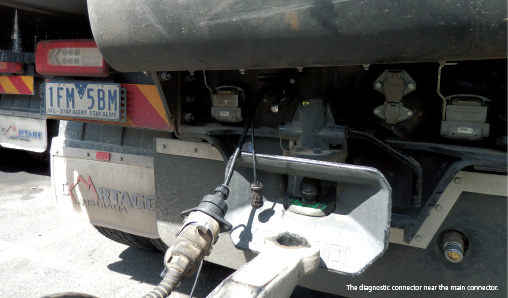As part of its dedication to education, Gough Transport Solutions is showing its customers how to get the most out of their braking equipment using information from the WABCO EBS operating data recorder.
A standard feature found in all WABCO Trailer Electronic Braking Systems (EBS), the Operating Data Recorder (ODR) is capable of tracking and recording data for over 600 trips. However, as it is a function that is sometimes overlooked by fleet operators, Nick Hope, Key Account Manager, Braking at Gough Transport Solutions (GTS), is taking on the task of educating his customers on how to use the information to get the most out of their equipment.
“The ODR is an essential tool for fleet managers and drivers. It collects data such as distance, speed, axle load and different types of braking events, such as brake pressures, prevented rollovers and disc pad thicknesses,” Nick says. “The data can then be extracted as a report, giving fleets accurate and detailed information to use for both short and long term analyses.”
Nick adds that as part of the GTS promise to offer ‘world class service’ to its customers, his team of experts gives advice on how to use the stored data to plan fleet movements more efficiently and educate drivers about their braking habits. The ability to help drivers understand the intricate details of how they use brakes is especially important, he says, as it provides an opportunity for drivers to change wasteful behaviors.
“In some cases, such as when drivers are transporting heavy aggregate loads, the data showed that they were consistently braking late and hard, which was wearing down the brakes and causing rotor and drum damage,” Nick explains. “Showing the drivers the data meant they could see exactly what they were doing and adjust their habits to go easier on the brakes.”
For one fleet, Nick says that analysing the data revealed that heavy brake pad wear was occurring due the particulars of the routes the vehicles were travelling, with high levels of braking evident around roundabouts, steep roads and stop/start traffic. “The operator was able to learn from the information and choose a better route that would minimise wear on the brakes,” Nick says. “By changing routes and educating its drivers on how to use brakes more efficiently, the fleet was not
only able to get the most out of its brakes, but also reduce fuel consumption and add 15,000km to its tyre life.”
As well as reports for analysis at the office, the system can also provide real time feedback to drivers, such as displaying a warning light on the truck’s dashboard when disc brakes reach a pre-determined pad thickness. “Using this information has helped one of our fleet customers to avoid brake failure and reduce unscheduled downtime by 30 per cent,” Nick explains – adding that parameters such as pad thickness and axle load can be specified depending on the type of trailer and its application.
“As part of the education service we provide, our experts work with the client on the ideal parameters to set to get the best out of the equipment,” Nick says. “The parameters can be specified either for the whole fleet, or individually for each trailer. Then, the operators can use that information to better schedule maintenance, avoid unnecessary wear on brakes through better route planning and re-educate their drivers on efficient braking practices. We think the ODR is an essential tool that is often underutilised, so we are helping our customers take advantage of it.”


